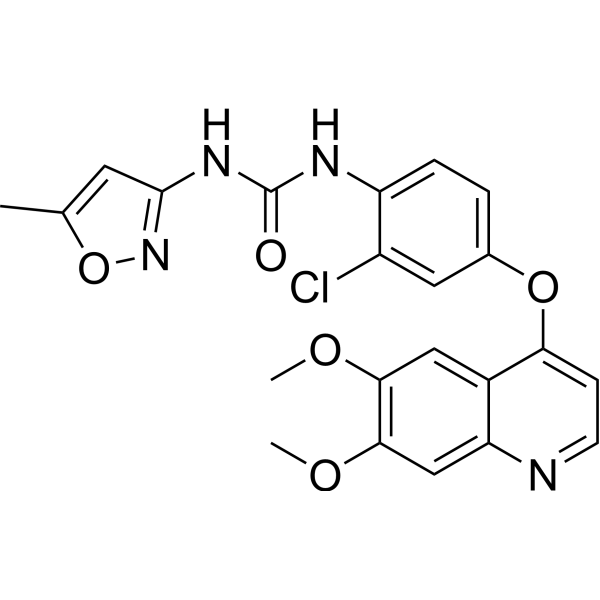Home
Products
Tivozanib (AV-951)



| Product Name | Tivozanib (AV-951) |
| Price: | Inquiry |
| Catalog No.: | CN00220 |
| CAS No.: | 475108-18-0 |
| Molecular Formula: | C22H19ClN4O5 |
| Molecular Weight: | 454.86 g/mol |
| Purity: | >=98% |
| Type of Compound: | Alkaloids |
| Physical Desc.: | Powder |
| Source: | |
| Solvent: | Chloroform, Dichloromethane, Ethyl Acetate, DMSO, Acetone, etc. |
| SMILES: | COc1cc2c(ccnc2cc1OC)Oc1ccc(c(c1)Cl)NC(=O)Nc1noc(c1)C |
| Contact us | |
|---|---|
| First Name: | |
| Last Name: | |
| E-mail: | |
| Question: | |
| Description | Tivozanib (AV-951; KRN951) is a highly potent and selective VEGFR 1/2/3 inhibitor with IC50s of 0.21, 0.16, and 0.24 nM in cell assay, respectively. |
| Target | VEGFR1:30 nM (IC50) VEGFR2:6.5 nM (IC50) VEGFR3:15 nM (IC50) |
| In Vitro | Tivozanib potently inhibits VEGF-induced VEGFR2 phosphorylation in endothelial cells (IC50=0.16 nM). It also inhibits ligand-induced phosphorylation of PDGFRβ and c-Kit (IC50=1.72 and 1.63 nM, respectively). Tivozanib blocks VEGF-dependent, but not VEGF-independent, activation of mitogenactivated protein kinases and proliferation of endothelial cells. It inhibits VEGF-mediated migration of human umbilical vein endothelial cells[1]. |
| In Vivo | Following p.o. administration to athymic rats, Tivozanib decreases the microvessel density within tumor xenografts and attenuates VEGFR-2 phosphorylation levels in tumor endothelium. It also displays antitumor activity against a wide variety of human tumor xenografts, including lung, breast, colon, ovarian, pancreas, and prostate cancer[1]. |
| Cell Assay | Cell-based assays are done to determine the ability of KRN951 to inhibit ligand-dependent phosphorylation of receptor tyrosine kinases. Briefly, the cells are starved overnight in appropriate basic medium containing 0.5% fetal bovine serum (FBS). Following the addition of KRN951 or 0.1% DMSO, the cells are incubated for 1 hour and then stimulated with the cognate ligand at 37°C. Receptor phosphorylation is induced for 5 minutes except for VEGFR3 (10 minutes), c-Met (10 minutes), and c-Kit (15 minutes). All the ligands used in the assays are human recombinant proteins, except for VEGF-C, a rat recombinant protein. Following cell lysis, receptors are immunoprecipitated with appropriate antibodies and subjected to immunoblotting with phosphotyrosine. Quantification of the blots and calculation of IC50 values are carried out[1]. |
| Animal Admin | Mice: Cancer cells are s.c. inoculated into the right flank of the athymic rats. Once established, tumors of 1,500 mm3 are surgically excised and smaller tumor fragments (20-30 mg) are s.c. implanted in the right flank of irradiated rats. Oral administration of KRN951 (0.2 or 1 mg/kg) or vehicle is initiated at the day of randomization (day 0). Tumor volume is measured twice weekly with Vernier calipers, and calculated[1]. |
| Density | 1.4±0.1 g/cm3 |
| Boiling Point | 550.4±50.0 °C at 760 mmHg |
| Flash Point | 286.7±30.1 °C |
| Exact Mass | 454.104401 |
| PSA | 107.74000 |
| LogP | 4.31 |
| Vapour Pressure | 0.0±1.5 mmHg at 25°C |
| Storage condition | -20°C |